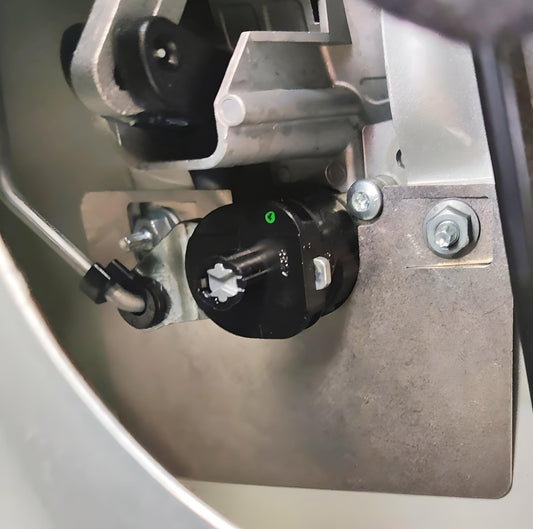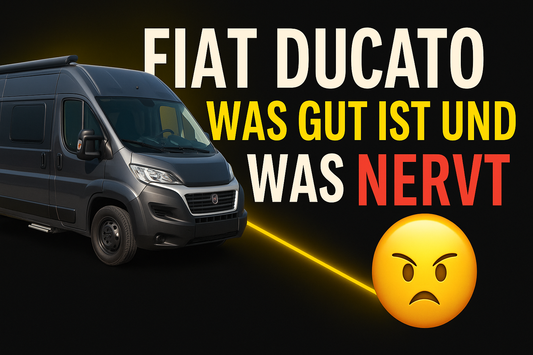After the dismantling with partition wall removal and new floor, the next big step in the conversion was on the agenda for us: the installation of a belt support and underfloor tanks. Both are important milestones that turn the pure van into an expandable motorhome. In this article, I describe the background to our decision, the process at the Heinrich company in Zeilingen and some of the practical problems we encountered.
Transparency note: I have no cooperation with this company.
Why a seatbelt support?
The Peugeot Boxer has three seats in the cab ex works. So you could have kept the partition wall and driven with three people in the front. This was certainly comfortable, even with a child seat the two-seater bench was acceptable. However, there were two clear disadvantages:
- The layout in the rear seemed less airy with the partition. In particular, the swivel front seats and the associated living space were missing.
- The child sat in the middle, right next to the gearshift and various controls - not an ideal solution from our point of view.
We therefore decided to remove the partition wall (see previous article) and retrofit a seat belt support in the living area.
Research and decision
The search for the right solution was more extensive than I had expected. Some considerations quickly turned out to be dead ends:
- Double-cab buses: do have rear benches ex works, but these are large, inflexible and cannot be integrated into the conversion in practice.
- Rail systems: Very flexible, but significantly more expensive than a fixed seat belt support.
In the end, the belt support remained the most sensible solution. We opted for a model from Reikon, which is sold by Wohnmobile Heinrich. The decisive factors were
- Comparatively low price,
- professional installation on site,
- significantly lower costs than comparable offers in Austria,
- and the fact that self-assembly would not have been practicable for subsequent type approval.
An additional advantage: Heinrich has templates and knows exactly where holes need to be drilled in order to attach the belt support to the vehicle carriers. Without these aids, precise installation would hardly have been possible.
The process on site
I made the appointment in advance by phone and email. The day before, I drove to Zeilingen and spent the night at the free parking space by the swimming pool. The next morning, I was able to drop off the vehicle on time and let the work begin.
In addition to the seatbelt support, we also ordered other components and had them installed:
- Underfloor tanks for fresh and waste water (approx. 80 liters each).
- Upholstery and plywood cladding for the seatbelt support.
- Seats from Aguti and Sportscraft.
The seats and their special features
Since we wanted to install swivel consoles, the seat height was an issue. The Aguti seats have the advantage that they are flatter and therefore compensate for the additional height of the swivel consoles. This allowed me to keep the original seat frame for the driver's seat, which later proved to be practical as the battery could be installed there. The passenger seat was fitted with a lower Sportscraft frame, which made the seating position more comfortable for my wife.
One problem arose with the upholstery: The Heinrich company sells the rear seat upholstery in a design that actually matches the original Fiat seats. However, this design is not available for the Aguti seats sold. We were also mistakenly sold upholstery for the front seats that did not fit. It was possible to return them, but it was then difficult to find a replacement product in a matching color. We only noticed this after completing the conversion, as we had assumed that the seats and upholstery would match. In the end, we were able to solve the problem via a supplier and now have custom-made seat covers. They are not quite as accurate as the original upholstery, but they serve their purpose well enough.
Note: By removing the original two-person bench seat, the connector for the seat recognition (belt tensioner/airbag system) must be bridged with an airbag resistor. This is a safety-relevant point, which I will describe in detail in a separate article.
Underfloor tanks
The two underfloor tanks for fresh and waste water each hold around 80 liters. The big advantage: the interior remains free of bulky tanks. However, there was a technical problem: the exhaust gas routing in my van was solved differently to the factory-fitted motorhomes. The tailpipe extended further to the rear, so that the filler neck could not be fitted at first. Only after I had shortened the tailpipe and led it out to the side was there enough space for it to be fitted correctly.

Overnight stay before installation
I spent the night before the appointment at the parking space in Zeilingen. The site is free and right next to the swimming pool - convenient for anyone having work done there. However, the overnight stay showed once again: without insulation, it is cold and damp in the vehicle. The walls were full of condensation in the morning. A normal condition for an uninsulated van, but a good indication of how important insulation is later on.
Financial aspects: NOVA in Austria
By installing the seatbelt support and removing the partition wall, our vehicle was transformed from a commercial vehicle into a camper van. This not only has technical consequences, but also tax consequences. In Austria, the standard consumption tax (NOVA) is due as a result. It is calculated according to the vehicle value and CO₂ emissions in the year of retyping - not in the year of initial registration.
We were lucky that the 2.0 HDI engine has low fuel consumption. Nevertheless, the NOVA was a considerable additional cost item, which you should definitely plan for as an Austrian upgrade. This section is less relevant for readers from Germany, as different regulations apply there.
Conclusion
The installation of the belt support and the underfloor tanks was a technical milestone. For the first time, the vehicle was in a configuration that allowed it to be classified as a motorhome at a later date. However, there was still no question of "finished" or "camping feeling" at this point - the vehicle was still in a shell state. But the first safety and registration-relevant components had been installed, on which everything else could be built.
- Three seats in the front are practical, but not a good solution for families in the long term - a seat belt support creates safety and a feeling of space.
- Double-cabin buses are hardly suitable for do-it-yourself conversions, rail systems are expensive - a belt support is usually the best choice.
- Installation by specialist companies saves time and ensures TÜV approval.
- When removing the two-seater bench: pay attention to the airbag plug - bridge with resistor necessary.
- Underfloor tanks save space, but can be obstructed by exhaust pipes - check installation beforehand.
- Austria: Always factor in NOVA costs when retyping.
The next article deals with the installation of windows and roof hatches: which models we have chosen, why the curvature was problematic during installation and how the windows have proven themselves in everyday use.





